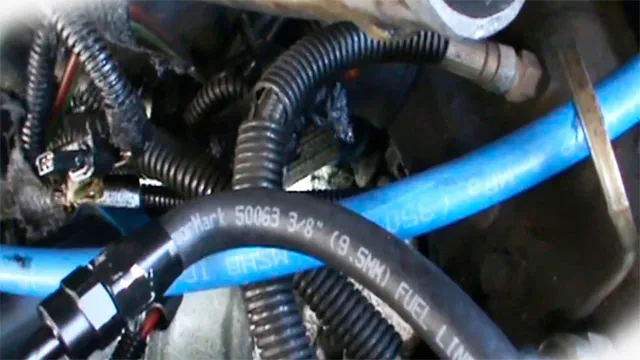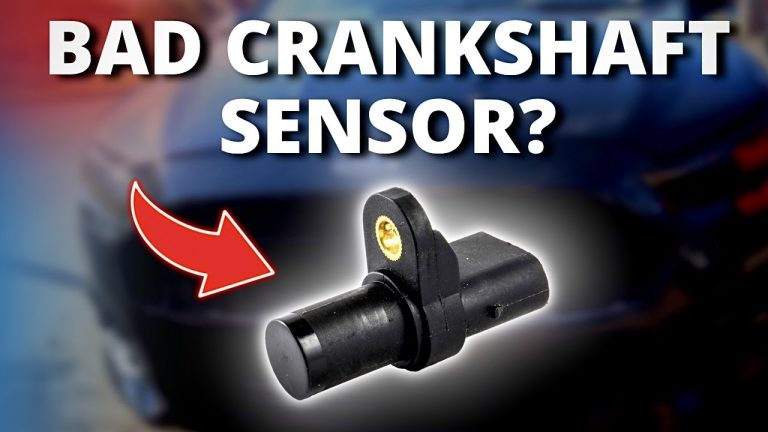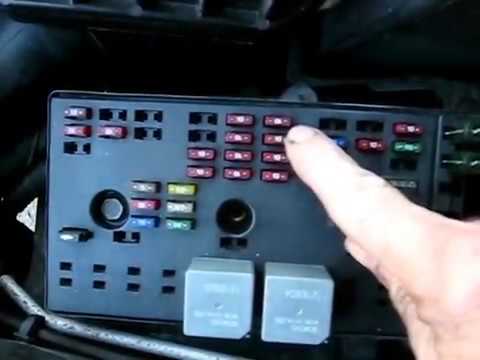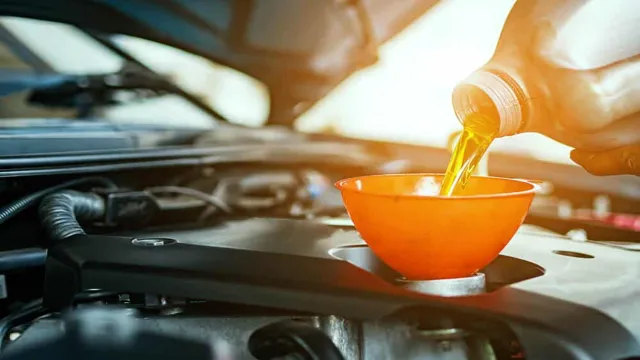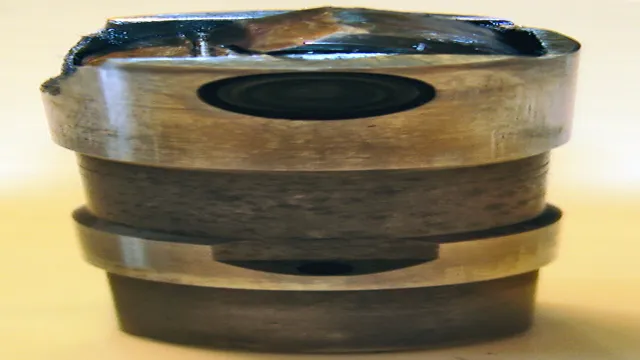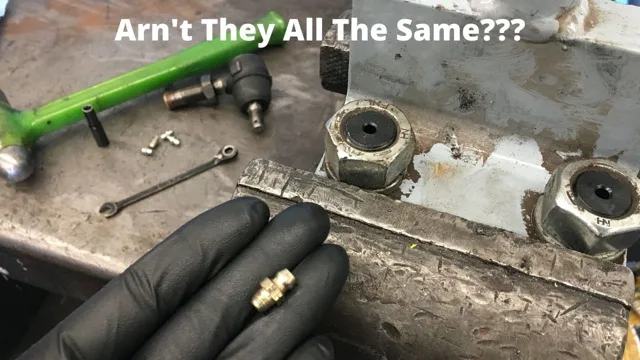Bleeding Your 6.0 Powerstroke Fuel System: A Step-by-Step Guide to Keeping Your Engine Running Smoothly!
If you own a 6.0 Powerstroke engine, you may encounter issues related to the fuel system over time. One of the common problems that arise is air trapped in the fuel lines, causing poor engine performance and stalling.
This is where bleeding the fuel system comes in. Bleeding the fuel system is a simple yet crucial maintenance task that involves getting rid of the trapped air and ensuring the fuel system functions optimally. In this post, we’ll walk you through the process of how to bleed the fuel system on a 6.0 Powerstroke, step-by-step, so that you can keep your engine running smoothly.
What is an Engine Bleed System?
The engine bleed system is critical for maintaining optimal engine performance. This system helps remove air from the fuel lines to ensure a continuous and smooth supply of fuel to the engine. When air enters the fuel system, it can cause various issues, including poor engine performance and even damage. This process is particularly important for Powerstroke engines, known for their power and durability.
Powerstroke engines, especially the 6.0 Powerstroke models, require precise fuel management to deliver the performance they are famous for. Understanding the engine bleed system in these engines can help you maintain their longevity and efficiency.
Understanding the Fuel System in Powerstroke Engines
Powerstroke engines have a complex fuel system designed to deliver fuel efficiently and consistently. This system includes components such as fuel injectors, fuel pumps, and fuel lines. Each part plays a crucial role in ensuring that the engine receives the right amount of fuel at the right time.
Proper maintenance of the fuel system is essential to prevent issues like fuel starvation or airlocks. Regular checks and maintenance routines can help identify problems early and prevent costly repairs down the line.
Signs of a Bleeding Fuel System
Identifying the signs of a bleeding fuel system early can save you from significant engine troubles. Here are some common symptoms to watch out for:
- Engine Misfires: If your engine is misfiring or not running smoothly, it could be a sign that air has entered the fuel system.
- Difficulty Starting: Air in the fuel lines can make it difficult for the engine to start. If you notice prolonged cranking times, it’s time to check the fuel system.
- Reduced Performance: A noticeable drop in engine performance, such as reduced power or acceleration, might indicate a bleeding fuel system.
Early detection of these symptoms is crucial. Addressing them promptly can prevent more severe damage to your engine and ensure it continues to perform at its best.
Step-by-Step Guide to Bleeding the Fuel System
Bleeding the fuel system in Powerstroke engines, particularly the 6.0 Powerstroke, is a task that requires careful attention to detail. Here is a step-by-step guide to help you through the process:
- Preparation:
- Ensure your vehicle is parked on a level surface.
- Disconnect the battery to prevent any accidental electrical discharge.
- Gather the necessary tools, including a wrench and a container to catch any fuel.
- Locate the Fuel Filter:
- The fuel filter is typically located near the engine. Refer to your vehicle’s manual for the exact location.
- Release the Pressure:
- Open the fuel cap to release any pressure in the fuel tank.
- Use a wrench to loosen the fuel filter cap slowly. Be prepared to catch any fuel that might spill.
- Bleeding the System:
- Turn the ignition key to the “On” position without starting the engine. This will activate the fuel pump and help push any air out of the system.
- Keep the ignition in this position for a few seconds, then turn it off. Repeat this process a few times.
- Check for Air:
- After bleeding the system, check the fuel filter for any remaining air bubbles. If you see bubbles, repeat the bleeding process until the fuel runs smoothly without air.
- Reassemble and Test:
- Tighten the fuel filter cap.
- Reconnect the battery.
- Start the engine and check for any issues. If the engine runs smoothly, the bleeding process was successful.
By following these steps, you can effectively bleed the fuel system in your Powerstroke engine, ensuring it runs efficiently and reliably.
What You’ll Need
If you’re wondering how to bleed the fuel system on your 6.0 Powerstroke, there are a few things you’ll need before getting started. The first thing you’ll need is an actual fuel system bleed kit, which contains the necessary hardware for bleeding your fuel system.
You’ll also need a chunk of time, as this process can take some time to complete. In addition, you’ll need protective gear like gloves, as fuel can be dangerous and harmful to your skin. Finally, you’ll need some basic knowledge of how your fuel system works in order to properly execute the bleed.
It’s always a good idea to consult your vehicle owner’s manual or a professional mechanic if you’re unsure about any aspect of the fuel system or the bleed process. By properly equipping yourself, you’ll be able to safely and effectively handle the task at hand.
List of required tools and equipment
If you’re planning on taking on a DIY project, it’s important to make sure you have all the necessary tools and equipment. Depending on the project, you may need a variety of tools, such as a saw, hammer, drill, level, measuring tape, and screwdrivers. It’s also important to have safety equipment on hand, such as goggles, gloves, and a dust mask.
If you don’t already have these items, it’s worth investing in good quality tools to make the job easier and ensure safety. Consider purchasing a toolbox or organizing system to keep all your tools in one place for easy access. Don’t forget to read the manufacturer’s instructions for each tool and make sure you know how to use them properly before starting your project.
With the right tools and equipment, your project is sure to be a success!
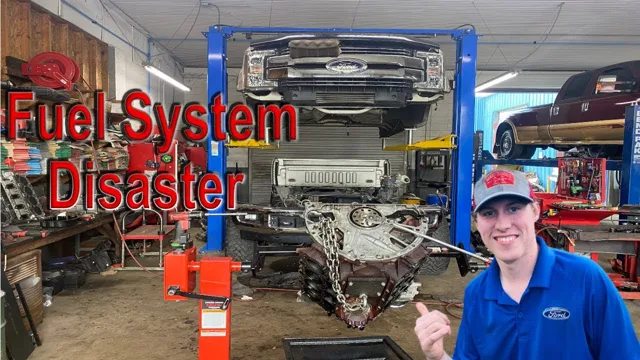
Step 1: Prepare Your Vehicle
If you’re wondering how to bleed the fuel system on a 6.0 Powerstroke, the first step is to prepare your vehicle. Start by parking it on level ground and turning off the engine.
Ensure that you’ve got all the necessary tools and materials ready, such as fuel filters, fuel line disconnect tools, and a fuel pressure gauge. Make sure that you have enough light to see what you’re doing, as this process can be tricky and may require some patience. Before starting the bleeding process, it’s important to inspect the fuel system and identify any leaks or damaged fuel lines.
Once you’ve confirmed that everything is in order, you can proceed with removing the old fuel filters and installing new ones. This will help aid in removing any air pockets in the fuel lines and help fuel flow freely. Then, use a fuel line disconnect tool to remove the fuel line from the fuel pressure regulator.
Attach a fuel pressure gauge to the port and turn the key to the “On” position without starting the engine. This will allow the fuel pump to run and pressurize the system, helping to push any air pockets out. Once you’ve achieved a consistent fuel pressure reading, turn off the key and reattach the fuel line to the regulator.
This step prepares the fuel system for bleeding and helps ensure that you’re starting with a clean slate.
Turning off the engine and ensuring the system is depressurized
Before you start any work on your vehicle’s fuel system, it’s important to turn off the engine and ensure that the system is depressurized first. This ensures that no fuel will be spraying out when you start removing parts of the system. To prepare your vehicle, start by locating the fuel pump fuse or relay and removing it to turn off the fuel pump.
Then, start the engine and let it run out of fuel. Once it has stopped running, you can verify that the fuel system is depressurized by locating the test valve on the fuel rail and pressing the valve core to see if any fuel is released. If you see fuel, then the system is still pressurized and needs to be depressurized before you can start working on it.
Taking these steps is important for your safety and the safety of your vehicle. By following these guidelines, you can ensure that you will be able to work on your fuel system without any accidents or injuries.
Step 2: Locate the Fuel Filter
If you are wondering how to bleed fuel system on 6.0 Powerstroke, one of the crucial steps is locating the fuel filter. The fuel filter is typically situated on the driver’s side under the hood, just beneath the brake master cylinder.
It could look like a metal cylinder with pipes on the top and bottom. Once you have located the fuel filter, you can proceed to prepare the fuel lines for bleeding. Before beginning any work on the fuel system, ensure that the engine is cool, and your vehicle’s power is off.
Furthermore, take note of the filter’s orientation because you need to reinstall it in the same direction. Make sure that you have the right tools before starting the process so that you can work efficiently and safely. By locating the fuel filter, you have taken the first step towards solving the problem and getting your 6.0 Powerstroke running smoothly again.
Identifying the location of the fuel filter
Now that you have safely parked your car and know what to look for, it’s time to locate the fuel filter. Finding the fuel filter can be tricky as it varies from model to model, but generally, it can be found close to the fuel tank or engine. If you’re not sure where to look, consult your car’s manual or search online for the location of the fuel filter for your make and model.
You may also need to remove some engine components to access the filter, so make sure you have the right tools on hand, such as pliers, screwdrivers, and a wrench. Once you locate the filter, take a moment to inspect it for any signs of wear or damage. If you notice any cracks or leaks, then it’s time to replace the filter immediately.
Remember, a clean fuel filter translates to better engine performance, increased fuel efficiency, and improved overall drivability.
Step 3: Remove Air From The Fuel System
When it comes to bleeding the fuel system on a 6.0 Powerstroke, removing air is a crucial step. Air can cause the engine to sputter or stall, and poor fuel efficiency.
To begin, locate the fuel filter and replace it if needed. Then, turn the key to the “on” position without starting the engine and wait for the fuel pump to prime. Next, find the fuel pressure release valve on the fuel rail and loosen it until fuel comes out.
This will release any trapped air in the fuel lines. Finally, crank the engine and let it idle for a few minutes to ensure all the air is expelled from the system. It’s important to remember that this process may need to be repeated multiple times to ensure all the air is removed from the fuel system.
By following these steps, you can help your 6.0 Powerstroke run smoothly and efficiently.
Detailed instructions for purging air out of the fuel system
When it comes to removing air from your fuel system, there are a few steps you need to follow to ensure it’s done correctly. Step 3 involves actually removing the air from the system itself. This can be done in a variety of ways depending on your specific fuel system setup.
One common method is to use a hand pump or lift pump to pull fuel through the lines and remove the air bubbles. This can take a few minutes and may require some trial and error to get just right. It’s important to ensure that all the air bubbles are removed before starting your engine to prevent any damage.
Additionally, double-check that all fuel lines and connections are tight and secure before running your engine. By following these steps carefully, you can successfully purge your fuel system of air and ensure your engine runs smoothly.
Step 4: Inspect the System
After bleeding the fuel system on your 6.0 Powerstroke engine, the next step is to inspect the system to ensure it’s functioning correctly. Start by checking the fuel lines and connections for any leaks or damage.
Check the fuel filter for signs of damage or contamination, and replace it if necessary. Monitor the fuel pressure gauge to ensure it’s within the manufacturer’s recommended range. If the fuel pressure is too low or too high, it can result in poor performance or even engine damage.
You should also monitor the engine oil level and quality, as poor fuel quality can cause premature wear on engine components. Finally, take the time to check for any warning lights or error codes on your dashboard, as these can indicate underlying problems that need to be addressed. With a thorough inspection, you can be confident that your 6.0 Powerstroke engine is running smoothly and efficiently.
Checking for leaks and damages in the fuel system
When it comes to ensuring the safety and proper functioning of your fuel system, it’s important to regularly inspect it for any leaks or damages. This is especially crucial if you suspect that there’s an issue with your fuel system, such as decreased fuel efficiency or a noticeable odor coming from your vehicle. To inspect the system, start by looking for any signs of leaks or damage to the fuel tank, fuel lines, and fuel injectors.
Check for any visible cracks, rust, or corrosion, and pay close attention to any unusual smells or sounds. If you notice any issues, be sure to have them repaired as soon as possible, as even small leaks or damages can quickly escalate into major problems that could put your safety and the safety of others at risk. By taking the time to inspect your fuel system on a regular basis, you can help ensure that your vehicle performs well and that you avoid any potentially dangerous situations on the road.
Step 5: Test Your Engine
After bleeding the fuel system on your 6.0 Powerstroke, the next step is to test your engine. This is to ensure that all air pockets have been removed and that fuel is flowing correctly.
To do this, start your engine and let it run for a few minutes. Keep an eye on the fuel pressure gauge if you have one, and listen for any unusual sounds. If everything seems right, rev the engine a few times and see if any issues arise.
If you notice any problems, turn the engine off and re-check the fuel system for any leaks or air pockets. It’s always better to be safe than sorry, so don’t skip this important step. Testing your engine after bleeding the fuel system is crucial for optimal engine performance and longevity in the future.
Running your engine to test its performance
Once you have installed your engine and double-checked everything, it’s time to fire it up and test its performance. You’ll want to do this in a well-ventilated area while wearing hearing protection and keeping a fire extinguisher nearby. Before starting the engine, check that the oil pressure is good and that there are no leaks or strange sounds coming from the engine.
Start the engine and let it warm up to its operating temperature, usually indicated by the engine’s temperature gauge. Once the engine is warm, test its performance by gradually increasing the throttle. Keep an eye on the gauges and listen for any strange noises or vibrations.
You may need to tweak the fuel and ignition settings to optimize performance. Remember that it may take a few runs to get the engine running smoothly. With patience and careful tuning, you can get the most out of your engine and enjoy a smooth, reliable ride.
Common Mistakes and How to Avoid Them
Even with the best intentions, mistakes can happen during the fuel system bleeding process. Here are some common errors and how to avoid them:
- Rushing the Process:
- Take your time with each step. Rushing can lead to incomplete bleeding, leaving air in the system.
- Not Checking for Leaks:
- After bleeding the system, always check for leaks around the fuel filter and connections. Leaks can lead to air entering the system again.
- Ignoring Safety Precautions:
- Always disconnect the battery before starting the bleeding process to prevent accidental electrical discharge.
By avoiding these common mistakes, you can ensure a smooth and successful bleeding process, keeping your engine in top condition.
The Importance of Professional Maintenance
While DIY maintenance is essential, there are times when professional help is necessary. Regular professional maintenance can provide several benefits:
- Expertise:
- Professional mechanics have the knowledge and experience to identify and address issues that might not be apparent to the average vehicle owner.
- Advanced Tools:
- Professionals use advanced diagnostic tools to detect problems early and accurately, preventing more significant issues down the line.
- Peace of Mind:
- Regular professional maintenance ensures that your fuel system is in optimal condition, giving you peace of mind and confidence in your engine’s performance.
Knowing when to seek professional help and what to expect during a maintenance visit can help you make informed decisions about your vehicle’s care.
Conclusion
In conclusion, bleeding the fuel system on a 6.0 Powerstroke is a bit like performing open heart surgery on a diesel engine. It requires patience, precision, and a steady hand.
But fear not, with a little know-how and some elbow grease, you too can be a master mechanic and keep your engine running smoothly. So grab your tools and get to work, and remember, a properly bled fuel system is the key to a happy and healthy Powerstroke. Happy wrenching!”
Summary of the entire procedure and troubleshooting tips
Now that you’ve completed the previous four steps, it’s time to test your engine and see if all your hard work has paid off. Before starting your engine, check that all connections are tight, and the spark plugs are properly installed. Then turn the key and listen for any unusual noises.
If you hear a knocking sound, that may indicate a problem with the engine’s fuel, ignition or timing system. Check the timing and try to adjust it accordingly. If the engine is struggling to start, it may be due to a flooded carburetor.
In this case, let the engine sit for a few minutes before attempting to start again. Keep in mind that some newly rebuilt engines may require a few adjustments before running smoothly. Be patient and persistent, and you’ll soon be cruising down the road with a fully functioning engine.
FAQs
What are the symptoms of air in the fuel system on a 6.0 powerstroke?
The symptoms of air in the fuel system may include hard starting, rough idle, loss of power, and stalling.
How do I bleed the fuel system on a 6.0 powerstroke?
To bleed the fuel system on a 6.0 powerstroke, first, remove the fuel filter and fill it with diesel fuel, then open the fuel drain valve and allow fuel to drain until there is no air in the system. Next, prime the fuel system until fuel flows freely from the fuel return line, then replace the fuel filter and start the engine.
Can I bleed the fuel system on a 6.0 powerstroke myself, or should I take it to a mechanic?
While it is possible to bleed the fuel system on a 6.0 powerstroke yourself, if you are not comfortable working with diesel fuel or are unsure of what to do, it may be best to take it to a mechanic.
How often should I bleed the fuel system on a 6.0 powerstroke?
It is recommended that you bleed the fuel system on a 6.0 powerstroke every time you change the fuel filter, or if you suspect air has entered the system.

